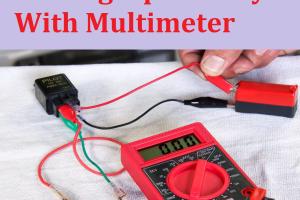Ultimate Guide on How to Test a Relay: Step-by-Step Instructions

-
Quick Links:
- Introduction
- Understanding Relays
- Tools Needed for Testing a Relay
- Step-by-Step Guide to Testing a Relay
- Common Issues with Relays
- Case Studies and Examples
- Expert Insights on Relay Testing
- FAQs
- Conclusion
Introduction
Testing a relay is a critical skill for anyone involved in electrical work, whether you're a hobbyist or a professional. Relays are essential components in various electrical systems, acting as switches that open and close circuits when activated by an electrical signal. Understanding how to test a relay ensures that your electrical systems function effectively and efficiently.
Understanding Relays
A relay is an electromagnetic switch that allows you to control a high-power circuit with a low-power signal. They are commonly used in automotive applications, home appliances, and industrial machines. The basic components of a relay include:
- Coil: The electromagnetic part that creates a magnetic field when voltage is applied.
- Armature: A movable part that opens and closes the contacts.
- Contacts: Metal pieces that either allow or interrupt electrical flow.
- Spring: A component that returns the armature to its original position when the coil is deactivated.
Tools Needed for Testing a Relay
Before you start testing a relay, ensure you have the following tools:
- Digital Multimeter (DMM)
- Power Source (e.g., battery or power supply)
- Test Leads
- Wiring Diagram of the Relay
- Screwdriver (for accessing the relay if necessary)
Step-by-Step Guide to Testing a Relay
Step 1: Visual Inspection
Start with a visual inspection of the relay. Look for any signs of damage, burn marks, or corrosion on the terminals. If the relay appears damaged, it may need replacement.
Step 2: Set Up the Multimeter
Set your digital multimeter to the Ohm setting to measure resistance. This will help you check the coil’s continuity.
Step 3: Test the Relay Coil
Connect the multimeter leads to the coil terminals of the relay. A good relay coil should show a resistance value typically between 50 to 120 Ohms. If your multimeter shows infinite resistance, the coil is open and the relay is faulty.
Step 4: Power the Relay
Connect the relay to a power source according to its specifications. Ensure you follow the wiring diagram. Apply voltage while keeping the multimeter connected to the contact terminals.
Step 5: Check the Contacts
When the relay is powered, use the multimeter to check the contacts. A functional relay will show continuity between the normally open (NO) and common (COM) terminals. If there's no continuity, the relay is malfunctioning.
Step 6: Deactivate the Relay
Remove the power supply and check the normally closed (NC) contacts. There should be continuity between NC and COM. If there’s none, the relay is faulty.
Common Issues with Relays
Understanding common relay issues can help you troubleshoot effectively:
- Sticking Contacts: This occurs due to oxidation or mechanical wear, causing the contacts to remain closed.
- Burnt Coil: Overvoltage can burn the coil, leading to an open circuit.
- Corrosion: Corroded terminals can lead to poor conductivity.
Case Studies and Examples
Here are a couple of real-world scenarios demonstrating relay testing:
Case Study 1: Automotive Relay Failure
A car owner experienced issues with the headlights flickering. Upon testing the relay, it was determined that the coil was burnt. Replacing the relay resolved the issue.
Case Study 2: Home Appliance Relay
A malfunctioning washing machine was traced back to a faulty relay. Testing revealed an open circuit in the contacts, leading to a simple relay replacement that restored functionality.
Expert Insights on Relay Testing
Experts suggest regular testing of relays in critical applications to avoid unexpected failures. They recommend using a multimeter with a low resistance scale for accurate readings and keeping a spare relay on hand for quick replacements.
FAQs
1. What is a relay?
A relay is an electromagnetic switch that controls a high-power circuit using a low-power signal.
2. How can I tell if a relay is bad?
Test the relay using a multimeter. If the coil shows infinite resistance or if there’s no continuity in the contacts, the relay may be bad.
3. Can I test a relay without a multimeter?
While a multimeter provides the most accurate readings, you can also perform a basic functional test by connecting the relay to a circuit and observing its operation.
4. What is the lifespan of a relay?
Typically, relays can last from 100,000 to 10 million cycles, depending on the type and how they are used.
5. Are all relays tested the same way?
While the general testing method is similar, specific procedures may differ based on relay types and configurations.
6. Can I repair a faulty relay?
It’s generally more cost-effective to replace a faulty relay than to attempt repairs, as they are relatively inexpensive.
7. What tools do I need to test a relay?
You will need a digital multimeter, power source, test leads, and a wiring diagram.
8. What should I do if the relay tests fine but the circuit still doesn't work?
Check for other issues in the circuit, such as broken wires or faulty components.
9. Can I test a relay in-circuit?
Yes, but it’s best to isolate the relay for more accurate testing.
10. What are the types of relays?
Common types include electromagnetic, solid-state, thermal, and reed relays.
Conclusion
Testing a relay is a straightforward process that is essential for maintaining reliable electrical systems. By following the steps outlined in this guide, you can effectively diagnose and troubleshoot relay issues, ensuring optimal performance in your applications. Regular testing and maintenance can prevent unexpected failures and extend the lifespan of your electrical components.
For more information on electrical components and troubleshooting techniques, check out these resources:
- Electronics Tutorials on Relay Testing
- AA1Car: Understanding Automotive Relays
- Engineering Toolbox: Relay Basics
Random Reads